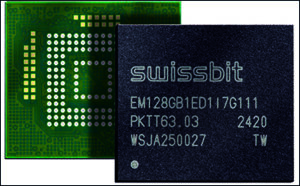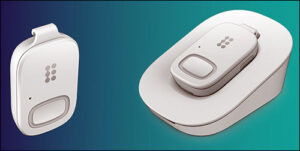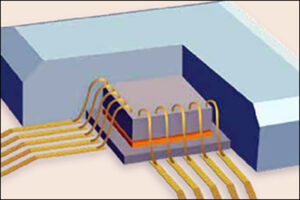Dec 16, 2021Presented here are recent news announcements regarding the following organizations: Sylvac, Insight SIP, Swissbit, the Digital Twin Consortium, Essence Group, STMicroelectronics and the LoRa Alliance.
Sylvac Adds Insight SIP BLE Modules to Measuring Tools
Sylvac SA, a Swiss manufacturer of measuring tools, has incorporated Bluetooth Low Energy (BLE) modules from Insight SIP, a provider of ultra-miniature RF modules, to enable connectivity features within its digital measuring instruments. Sylvac offers handheld and portable or benchtop instruments with digital readouts, including callipers, micrometres and depth gauges.
Within industrial and research processes, the company says the logging of data from its instruments carried the possibility of human error. The connectivity feature in the digital measuring instruments, Sylvac explains, allows the wireless transfer of data reading via a button press to a data-logging system, eliminating transcription errors. It offers an efficient method of taking multiple readings, thereby increasing productivity. BLE was chosen for the wireless communication protocol since it offers low power consumption, which is vital in battery-powered handheld tools, as well as versatility in connectivity through standardization.
The connectivity service offers the option to remotely configure instruments, in order to ensure repeatability and accuracy, the company reports. The solution can be paired and set up to communicate with other systems, and it allows over-the-air updates of the module for the addition of new features. Different instruments, according to Sylvac, can communicate with data-logging systems in a clear and structured manner.
The connectivity solution was first introduced into a dial-gauge product, and now it has been deployed across the company's product range. According to Sylvac, the pre-certified integrated component from Insight SIP simplifies what would otherwise be a laborious certification process for each new product. Insight SIP's miniature module design enabled the new functionality to be integrated without change to the external dimensions of the product casing.
Swissbit Extends Miniature Storage Solutions for IoT
Swissbit has extended its range of miniaturized storage solutions with the launch of its EM-30 series with an e.MMC-5.1 standard interface. The BGA device uses industrial-grade 3D-NAND and is available in capacities ranging from 16 to 256 GB. With the new series, Swissbit says it is responding to the increasing demands of embedded systems for ultra-small, vibration-resistant designs with escalating memory-capacity requirements.
 With a temperature range of -40 degrees to +105 degrees Celsius (-40 degrees to +221 degrees Fahrenheit), the EM-30 offers a remote secure firmware update option and an extended lifetime expectation, making it suitable for applications including POS/POI terminals, routers and switches, the company reports. It can also be sued for industrial automation, the Internet of Things (IoT), automotive or medical applications.
With a temperature range of -40 degrees to +105 degrees Celsius (-40 degrees to +221 degrees Fahrenheit), the EM-30 offers a remote secure firmware update option and an extended lifetime expectation, making it suitable for applications including POS/POI terminals, routers and switches, the company reports. It can also be sued for industrial automation, the Internet of Things (IoT), automotive or medical applications.
The EM-30 product series complies with e.MMC-5.1 specifications and is downward-compatible. The device provides sequential data rates of up to 300 megabytes per second for reading and 230 megabytes per second for writing, as well as 40 and 42 k IOPS for read and write random access. The EM-30 is designed for an industrial temperature range of -40 to +85 degrees Celsius (-40 to +185 degrees Fahrenheit) as standard, according to the company.
The device offers the option to access detailed information about the consumption of the write cycles and internal resources via standard access to the e.MMC registers, without the need for special access methods or drivers, the company reports. Firmware supports automatic background data refresh of read-only areas that occur with boot media. This feature, coupled with error correction, ensures that data availability is reliable, Swissbit says, even if data has not been accessed under prolonged periods of exposure to high temperatures.
Digital Twin Consortium Intros Interoperability Framework
The Digital Twin Consortium has announced the launch of its Digital Twin System Interoperability Framework, designed to characterize multiple facets of system interoperability based on seven key concepts to create complex systems that interoperate at scale. The framework is intended to enable collaboration across and within disciplines, including mechanical, electronic and software, within a single domain and across multiple domains.
 "Interoperability is critical to enable digital twins to process information from heterogeneous systems," said Dan Isaacs, the Digital Twin Consortium's CTO, in a prepared statement. "The Digital Twin System Interoperability Framework seeks to address this challenge by facilitating complex system of systems interactions. Examples include scaling a smart building to a smart city to an entire country, or an assembly line to a factory to a global supply chain network."
"Interoperability is critical to enable digital twins to process information from heterogeneous systems," said Dan Isaacs, the Digital Twin Consortium's CTO, in a prepared statement. "The Digital Twin System Interoperability Framework seeks to address this challenge by facilitating complex system of systems interactions. Examples include scaling a smart building to a smart city to an entire country, or an assembly line to a factory to a global supply chain network."
With billions of interconnections implemented daily, designers can codify, standardize, identify and reuse models in various use cases in the field. The framework's holistic information flow provides an understanding of the real world for optimal decision-making, the organization explains, in which a "world" can be a building, utility, city, country or other dynamic environment. The state of an entity encompasses all that entity's static and dynamic attribute values at a given point in time. The framework includes federated repositories, enabling users to access and correlate distributed, heterogeneous information across multiple dimensions of a digital twin, spanning time and lifecycle.
Essence Group Unveils Real-Time Personal Emergency Response System
Essence Group, which develops IoT-based security, safety and healthcare solutions for homes, families and businesses, has announced a 5G-enabled mobile personal emergency response system (mPERS). The solution, known as Umbrella mPERS, can be integrated with Essence Group's multi-service cloud. Featuring built-in fall detection, real-time activity monitoring and two-way voice capabilities, it is designed for a range of personal security and care settings, the company reports, including senior care and lone worker scenarios.
 "The Umbrella mPERS solution exemplifies our commitment to providing our partners with breakthrough technology," said Haim Amir, Essence Group's CEO and founder, in a prepared statement. "It highlights the potential for a new wave of interconnected security and personal safety devices leveraging the latest cellular IoT infrastructure. It allows security and care providers to offer greater peace of mind to their customers with advanced and more reliable services and a range of capabilities, including life-saving functions such as panic detection, which triggers specific actions to immediately notify guardians or caregivers in case of emergency."
"The Umbrella mPERS solution exemplifies our commitment to providing our partners with breakthrough technology," said Haim Amir, Essence Group's CEO and founder, in a prepared statement. "It highlights the potential for a new wave of interconnected security and personal safety devices leveraging the latest cellular IoT infrastructure. It allows security and care providers to offer greater peace of mind to their customers with advanced and more reliable services and a range of capabilities, including life-saving functions such as panic detection, which triggers specific actions to immediately notify guardians or caregivers in case of emergency."
The water-resistant solution comes with geolocation and indoor location capabilities, allowing it to be used in a variety of indoor and outdoor settings. Connectivity to 5G CAT-M networks enhances reliability and accuracy, according to Essence Group, while its small form factor and lightweight design enables it to be discreetly attached to a lanyard or belt clip. The solution leverages CAT-M technology, as well as rechargeable battery technology with Qi wireless charging to improve convenience and usability.
Protavic Offers Conductive Adhesive for RFID Inlays
Protavic has announced its ACzE 10750 anisotropic conductive adhesive for the bonding and electrical contacting of semiconductor chips in flip-chip technologies. The ACzE 10750 is suitable for the assembly of RFID inlays and smart-card microcontrollers, the company reports. Headquartered in France, Protavic is part of Protex International, a family-owned company active in niche chemical markets.
 The ACzE 10750 is a one-component fast-heat curing and solvent-free adhesive. Possible curing cycles are 10 seconds at 170 degrees Celsius (338 degrees Fahrenheit), and less for higher temperatures under pressure. The storage stability is 9 months at +5 degrees Celsius (41 degrees Fahrenheit) or one year at -20 degrees Celsius (-4 degrees Fahrenheit). The ACzE 10750 has a high adhesion strength on various substrates, the company reports, as well as a long work life, and it is REACH-, ROHS- and halogen-free, as well as non-CMR.
The ACzE 10750 is a one-component fast-heat curing and solvent-free adhesive. Possible curing cycles are 10 seconds at 170 degrees Celsius (338 degrees Fahrenheit), and less for higher temperatures under pressure. The storage stability is 9 months at +5 degrees Celsius (41 degrees Fahrenheit) or one year at -20 degrees Celsius (-4 degrees Fahrenheit). The ACzE 10750 has a high adhesion strength on various substrates, the company reports, as well as a long work life, and it is REACH-, ROHS- and halogen-free, as well as non-CMR.
Protavic's specialties include capacitors and passive components, printed and integrated circuits, silver nanowires, and more. The company offers dam-and-fill, glob-top, die-attach, underfill and RFID technologies for the electronics, automotive, aerospace, optoelectronics and solar energy markets. Its Protavic subsidiary designs and develops resins, adhesives and inks for the electronics industry and offers solutions for optimized industrial processes.
IT Hardware Asset-Management Webinar Available for Online Viewing
On Dec. 9, 2021, RFID Journal hosted a webinar titled "Tales from the Field: Building and Running a Successful IT Hardware Asset-Management Program," sponsored by RF Code. During this webinar, Mario Giovannitti, the data center services manager at a large healthcare organization based in North Texas, shared his journey, successes and lessons learned implementing and running an integrated and active asset-management program.
Attendees of the webinar learned why Giovannitti's company chose an active RFID solution over a passive one, how its current solution enables business process and automation, some of the benefits that it achieved and more. A recording of the session, along with a PDF of the materials used, can now be viewed at RFID Journal's website.
RFID Journal Shares STMicroelectronics White Paper on NFC and Patient Safety
 Near Field Communication (NFC), a wireless connectivity technology based on RFID, allows contactless communication between a reader and a tag. STMicroelectronics, in a white paper titled "How NFC Can Help Pharmaceutical Brands Ensure Patient Safety," explains how NFC tags can be embedded in the packaging of medical supplies, such as medicines, vaccines or drug samples, to add wireless connectivity, allow pharmaceutical brands to track products worldwide, ensure authenticity, and create a two-way communication channel with consumers.
Near Field Communication (NFC), a wireless connectivity technology based on RFID, allows contactless communication between a reader and a tag. STMicroelectronics, in a white paper titled "How NFC Can Help Pharmaceutical Brands Ensure Patient Safety," explains how NFC tags can be embedded in the packaging of medical supplies, such as medicines, vaccines or drug samples, to add wireless connectivity, allow pharmaceutical brands to track products worldwide, ensure authenticity, and create a two-way communication channel with consumers.
Between 8 and 15 percent of all medications sold internationally are either fake or not of the correct standard, according to researched conducted by the World Health Organization. Billions of counterfeit drugs are traded around the world every year, STMicroelectronics explains, harming thousands of people, particularly in developing countries. It is, therefore, crucial to find solutions to increase patient safety and security, and this document is intended to facilitate the process. Learn more by downloading the white paper.
LoRa Alliance Expands LoRaWAN NetID Program
The LoRa Alliance, a global association of companies backing the open LoRaWAN standard for IoT low-power wide-area networks (LPWANs), has announced that it has enhanced and expanded its LoRaWAN NetID program. The changes will increase access to NetID licenses for LoRa Alliance members and non-members alike, which is expected to accelerate global roaming deployments.
"LoRaWAN is an open global standard with full roaming capabilities already available internationally and via satellite," said Donna Moore, the LoRa Alliance's CEO and chairwoman, in a prepared statement. "LoRaWAN is rapidly becoming ubiquitous. To support all LoRaWAN users for roaming worldwide, we have increased access to our NetID program, growing LoRaWAN's reach and enabling true global roaming."
NetID is a 24-bit network identifier assigned to LoRaWAN networks by the LoRa Alliance to allow network traffic to be recognized. The IDs are an essential element of roaming, the organization explains, because devices that leave their home network need to use a unique identifier that can be globally identified and allow roaming partners to recognize each other's traffic.
Broadening the LoRaWAN NetID program is expected to enable members to grow their networks and increase access to roaming, according to the LoRa Alliance. Members will continue to receive NetIDs as part of their membership, and those who want supplemental NetIDs will be able to license an unlimited number of Type 7 NetIDs for a management fee. Similarly, companies that are not members will now be able to purchase and license a limited number of Type 7 NetIDs. Companies that require more than this limit are encouraged to join the LoRa Alliance for additional licenses.
"Extending NetID availability allows the entire IoT LPWAN market to reap the benefits of LoRaWAN," Moore added in the prepared statement. "This will help companies address new application and facilitate stronger connections with LoRa Alliance members, driving new business opportunities. At the same time, it provides existing members with an easier path to scaling their own LoRaWAN operations, which in turn drives more partnerships via roaming, more innovation and additional revenue."

